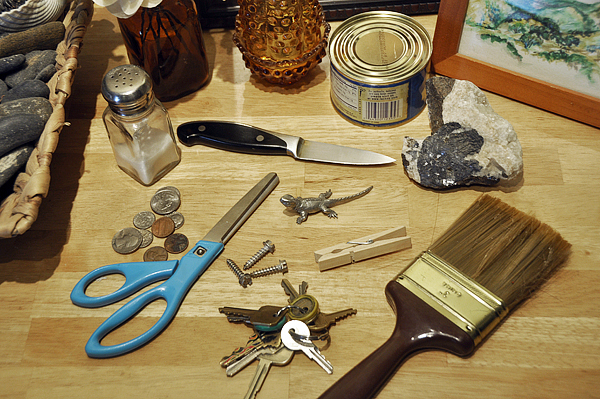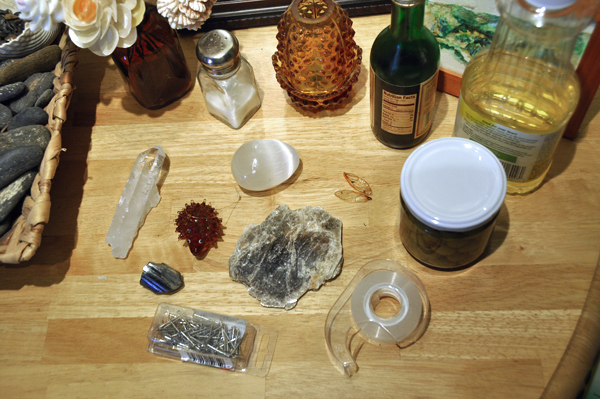At first, many people find luster a bit confusing. Luster is the way that an object reflects light, and although the different types of luster can be difficult to describe, your daily experience makes them easy to recognize. Once you understand luster, you will recognize the common lusters instantly.
Metallic Luster
The first step to identifying a specimen is to decide if it has a metallic or non-metallic luster. Luckily, you already know what metal looks like. All you have to do is ask yourself, does this look like a piece of metal? Remember that metals come in many different colors, such as gold, silver, copper, brass, iron, and aluminum. Metals can be very shiny like the chrome on your car, or they can be dull like a lead fishing weight. Even with all that variation, if you look at a pile of objects, you should find it very easy to pick out the ones that are made of metal, just by looking at them. Your brain already knows how to recognize a metallic luster.

Which of the items above are made of metal? Their metallic luster makes them easy to spot.
Want to test that? Take a minute to look at the room around you. How many objects can you see that are made of metal? Count how many different colors of metal you find. Notice that some are very shiny, and others are quite dull. Still, they all look like metal. They all have a metallic luster.
Vitreous Luster
The second most important luster is the vitreous luster. It is also the most common of all the lusters. Vitreous means glassy, so things with a vitreous luster look as if they are made of glass. Again, try to ignore color. Glass can come in any color. It can be transparent or opaque, but it still has a glassy luster.

Glass, plastic, minerals, and even insect wings can have a vitreous luster.
Look around the room again, this time looking for things that have a glassy luster. Not all of them will be made of glass. For example, many kinds of plastic have a glassy luster. Compare a plastic water bottle with a glass bottle. Both reflect the light in much the same way. They both have a vitreous luster. If you are in doubt, imagine that you have never seen the object before. Imagine that you have no idea what it is really made of. If you saw it on the ground, would you think, "Oh that looks like a piece of glass"? If the answer is yes, then it has a vitreous luster.
Other Lusters
Besides metallic and vitreous, there are several other lusters that you will probably run into as you study minerals. Some of them are fairly common, while others are only found in a few common minerals.
- Earthy Luster: Think about a piece of dirt. It is made up of very tiny grains, and it is dull, not shiny. When looking for an earthy luster, picture substances such as clay, chalk, potting soil, and ground cinnamon.
- Adamantine Luster: Like the vitreous luster, but VERY shiny. A diamond is a good example of the adamantine luster.
- Pearly Luster:Think about mother-of-pearl or the inside of a sea shell.
- Silky Luster: Fibrous. Looks as if it is made up of many thin fibers stuck together.
- Resinous Luster: Think about the way a piece of wax, amber, or tree sap reflects light. Not as shiny as the vitreous luster.
- Dull Luster: Not metallic, vitreous, or any of the others. Just what it says, dull.
Now take a look at your mineral specimens. Sort them into different lusters, and then compare your results with the Mineral Identification Chart. The more you practice with luster; the easier it gets.
